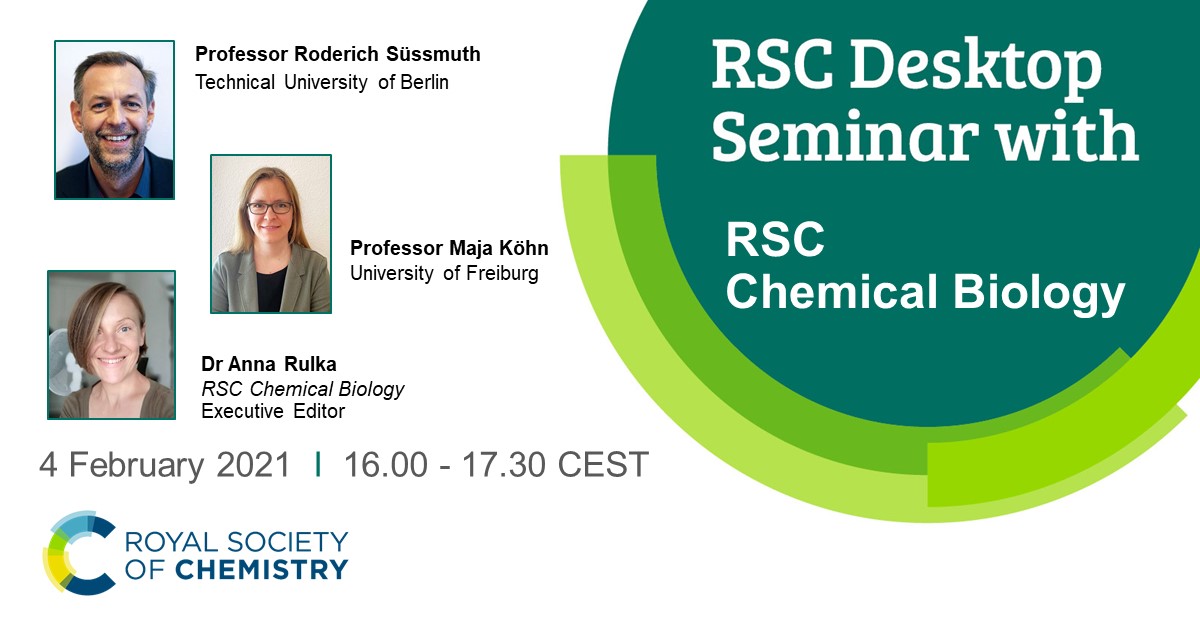
The RSC Chemical Biology “Editor’s choice” article collection
The ‘Editor’s choice’ collection for RSC Chemical Biology celebrates the very best work published in the journal to date, including regularly added articles personally chosen by our world-renowned Editorial Board, as well as those highlighted as “HOT” during the peer review process.
November
 |
This month, Associate Editor Gonçalo Bernardes is highlighting two exciting papers involving antibodies.
Professor Bernardes’s choices are detailed below. Access the full collection for free. |
Communication
Leucine-rich alpha-2-glycoprotein 1 (LRG1) as a novel ADC target
Faiza Javaid, Camilla Pilotti, Carlotta Camilli, David Kallenberg, Calise Bahou, Jack Blackburn, James R. Baker, John Greenwood, Stephen E. Moss and Vijay Chudasama
RSC Chem. Biol., 2021, 2, 1206-1220
DOI: 10.1039/D1CB00104C
Paper
Finding and characterizing a catalytic antibody light chain, H34, capable of degrading the PD-1 molecule
Emi Hifumi, Hiroaki Taguchi, Tamami Nonaka, Takunori Harada and Taizo Uda
RSC Chem. Biol., 2021, 2, 220-229
DOI: 10.1039/D0CB00155D
October
 |
After a summer break we were back with Associate Editor Andrea Rentmeister selecting two fantastic articles to highlight.
Professor Rentmeister’s choices are detailed below. Access the full collection for free. |
Review
Cell-free riboswitches
Takeshi Tabuchi and Yohei Yokobayashi
RSC Chem. Biol., 2021, 2, 1430-1440
DOI: 10.1039/D1CB00138H
Professor Rentmeister, “Cell-free systems with the ability to carry out complex functions are an important aspect of synthetic biology. This review focuses on cell-free riboswitches, an overview that has been missing so far. It introduces various prokaryotic and eukaryotic systems and highlights their applications.”
Paper
Click-based amplification: designed to facilitate various target labelling modes with ultralow background amplification
Jinyi Bai, Fusheng Guo, Mengyao Li, Yulong Li and Xiaoguang Lei
RSC Chem. Biol., 2021, 2, 906-916
DOI: 10.1039/D1CB00002K
Professor Rentmeister, “Bai et al present a versatile strategy to the problem of low signal that is often encountered when biological samples are labeled. In their “click-based amplification” a first azide is clicked to a biotin. Instead of using a regular streptavidin (SA), a modified SA with multiple azido-groups then serves as amplifier, allowing to click multiple biotins and to bind multiple reporter SAs. The authors achieved remarkable fluorescence enhancement in cultured cells and tissue.”
July
 |
In July, Editorial Board Member Ali Tavassoli selected two of his favourite articles to highlight.
Professor Tavassoli’s choices are detailed below. Access the full collection for free. |
Review
Proteolysis targeting chimeras (PROTACs) come of age: entering the third decade of targeted protein degradation
Michael J. Bond and Craig M. Crews
RSC Chem. Biol., 2021, 2, 725-742
DOI: 10.1039/ D1CB00011J
Professor Tavassoli, “PROTACs are an exciting new drug modality that hold much promise as potential therapeutics. This timely review provides an excellent summary of this important field and is a great starting point for those interested in learning more about PROTACs.”
Paper
Wheat pathogen Zymoseptoria tritici N-myristoyltransferase inhibitors: on-target antifungal activity and an unusual metabolic defense mechanism
Roman O. Fedoryshchak, Cory A. Ocasio, Benjamin Strutton, Jo Mattocks, Andrew J. Corran and Edward W. Tate
RSC Chem. Biol., 2020, 1, 68-78
DOI: 10.1039/ D0CB00020E
Professor Tavassoli, “This paper is an excellent example of the power and utility of chemical biology and chemical proteomics. The authors identify inhibitors of Z. tritici N-myristoyltransferase, and use these compounds in a chemical proteomics approach to profile the myristolated proteome in Z. tritici. These studies lead to the identification of an unusual mechanism by which the fungus defends itself from NMT inhibitors.”
June
 |
In June, three exciting articles were chosen by Editorial Board Member Jen Heemstra.
Professor Heemstra’s choices are detailed below. Access the full collection for free |
Review
Interfacing non-enzymatic catalysis with living microorganisms
Joanna C. Sadler, Jonathan A. Dennis, Nick W. Johnson and Stephen Wallace
RSC Chem. Biol., 2021, Advance Article
DOI: 10.1039/ D1CB00072A
Professor Heemstra, “Chemical catalysis and biocatalysis each have unique advantages and limitations toward the synthesis of high-value compounds. This review highlights recent progress in biocompatible chemistry, which empowers chemists to interface biotic and abiotic catalysts to develop improved synthetic routes.”
Communication
An activity-based fluorescent sensor for the detection of the phenol sulfotransferase SULT1A1 in living cells
Regina A. Baglia, Kira R. Mills, Koushambi Mitra, Jasmine N. Tutol, Darby Ball, Kierstin M. Page, Jyothi Kallu, Sriharika Gottipolu, Sheena D’Arcy, Steven O. Nielsen and Sheel C. Dodani
RSC Chem. Biol., 2021, 2, 830-834
DOI: 10.1039/ D0CB00231C
Professor Heemstra, “SULT1 enzymes play important roles in biology and this paper reports the first activity-based probe for an enzyme in this class. The naphthol-based sensor functions in vitro and in live cells, providing a useful tool for drug screening and the study of cellular functions of SULT1A1.”
Paper
Synthesis and application of a 19F-labeled fluorescent nucleoside as a dual-mode probe for i-motif DNAs
Wen Ann Wee, Ji Hye Yum, Shingo Hirashima, Hiroshi Sugiyama and Soyoung Park
RSC Chem. Biol., 2021, 2, 876-882
DOI: 10.1039/ D1CB00020A
Professor Heemstra, “Non-canonical DNA structures such as cytosine-rich i-motifs likely have biological importance yet are elusive to study. The authors report a new cytidine analogue that shows increased fluorescence enhancement upon folding and is also compatible with 19F NMR.”
April
 |
In April Associate Editor Roderich Süssmuth selected two high quality articles to add to the collection.
Below are his choices. Access the full collection for free. |
Review
Biosynthesis of alkyne-containing natural products
Xinyang Li, Jian-Ming Lv, Dan Hu and Ikuro Abe
RSC Chem. Biol., 2021, 2, 166-180
DOI: 10.1039/D0CB00190B
Professor Süssmuth, “A review article was long time due, since the alkyne group is of eminent importance in biological chemistry, particularly as a handle for the click reaction. It is interesting to see, that nature also synthesizes this functionality, which is present in various natural products.”
Paper
Intermediary conformations linked to the directionality of the aminoacylation pathway of nonribosomal peptide synthetases
Florian Mayerthaler, Anna-Lena Feldberg, Jonas Alfermann, Xun Sun, Wieland Steinchen, Haw Yang and Henning D. Mootz
RSC Chem. Biol., 2021, Advance Article
DOI: 10.1039/D0CB00220H
Professor Süssmuth, “The work addresses dynamics of non-ribosomal peptide synthetases. The understanding of the gross architecture of the NRPSs from x-ray structures is now followed in this study to understand the dynamics, an aspect of increasing importance.”
March
 |
In March it was the turn of Associate Editor Cai-Guang Yang to highlight three of his favourite articles to date.
Below are his choices. Access the full collection for free. |
Review
Labelling of DNA and RNA in the cellular environment by means of bioorthogonal cycloaddition chemistry
Dorothée Ganz, Dennis Harijan and Hans-Achim Wagenknecht
RSC Chem. Biol., 2020, 1, 86-97
DOI: 10.1039/D0CB00047G
Professor Yang, “This review summarizes DNA and RNA labelling by means of bioorthogonal cycloaddition chemistry in the cellular environment. It also describes current status of orthogonal dual and triple labelling of DNA and RNA in vitro to demonstrate the potential in vivo applications for future.”
Papers
Macrocyclic peptides that inhibit Wnt signalling via interaction with Wnt3a
Manuel E. Otero-Ramirez, Kyoko Matoba, Emiko Mihara, Toby Passioura, Junichi Takagi and Hiroaki Suga
RSC Chem. Biol., 2020, 1, 26-34
DOI: 10.1039/D0CB00016G
Professor Yang, “By applying a unique RaPID display screening technique, this work reports the first instance of de novo macrocyclic peptides acting as direct binders of a highly hydrophobic and not commonly targeted Wnt protein or similar unstable proteins.”
A live-cell assay for the detection of pre-microRNA–protein interactions
Sydney L. Rosenblum, Daniel A. Lorenz and Amanda L. Garner
RSC Chem. Biol., 2021, 2, 241-247
DOI: 10.1039/D0CB00055H
Professor Yang, “This work reports the efforts in the development of a new approach for detection of RNA–protein interactions (RPIs), RNA interaction with Protein- mediated Complementation Assay (RiPCA). RiPCA could serve as a useful tool for detecting RPIs in live cells.”
February
 |
February saw Associate Editor Seung-Bum Park has added his choice to the collection.
Below is Professor Park’s choice. Access the full collection for free. |
Communication
In vivo delivery of a fluorescent FPR2/ALX-targeted probe using focused ultrasound and microbubbles to image activated microglia
Sophie V. Morse, Tamara Boltersdorf, Tiffany G. Chan, Felicity N. E. Gavins, James J. Choi and Nicholas J. Long
RSC Chem. Biol., 2020, 1, 385-389
DOI: 10.1039/D0CB00140F
January
 |
In January we launched the collection with 3 papers chosen by our Editorial Chair, Professor Hiroaki Suga, alongside some of our hottest papers published in 2020.
Below are Professor Suga’s choices. Access the full collection for free. |
Review
The chemical biology of coronavirus host–cell interactions
Suprama Datta, Erik C. Hett, Kalpit A. Vora, Daria J. Hazuda, Rob C. Oslund, Olugbeminiyi O. Fadeyi and Andrew Emili
RSC Chem. Biol., 2021, 2, 30-46
DOI: 10.1039/D0CB00197J
Professor Suga, “This review timely and comprehensively summarizes the biological events linked to the coronavirus outbreak.”
Papers
A thorough analysis and categorization of bacterial interrupted adenylation domains, including previously unidentified families
Taylor A. Lundy, Shogo Mori and Sylvie Garneau-Tsodikova
RSC Chem. Biol., 2020, 1, 233-250
DOI: 10.1039/D0CB00092B
Professor Suga, “The families of interrupted A domains and types of M domains in nonribosomal peptide class of natural products have been categorized. It has illuminated patterns and insights on how to harness them for engineering studies in the future.”
Harnessing the PD-L1 interface peptide for positron emission tomography imaging of the PD-1 immune checkpoint
Kuan Hu, Lin Xie, Masayuki Hanyu, Yiding Zhang, Lingyun Li, Xiaohui Ma, Kotaro Nagatsu, Hisashi Suzuki, Weizhi Wang and Ming-Rong Zhang
RSC Chem. Biol., 2020, 1, 214-224
DOI: 10.1039/D0CB00070A
Professor Suga, “Authors of this paper have developed an impressive PET imaging tool for the most famous immune check point mediated by the PD-1 and PD-L1 interaction, demonstrating not only cell culture and ex vivo detection but also in vivo detection in mice.”
We hope you enjoy reading these articles!


 Featuring:
Featuring: